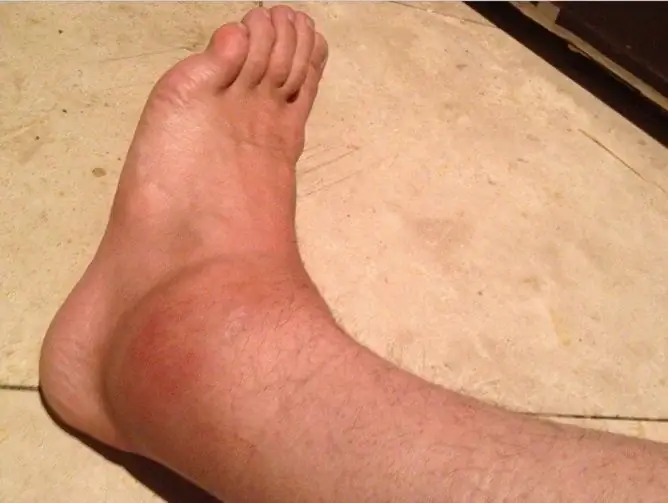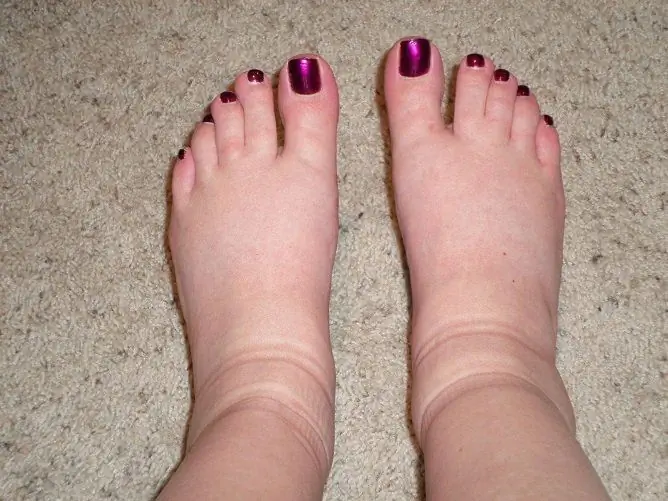- Author Rachel Wainwright [email protected].
- Public 2024-01-15 19:51.
- Last modified 2025-11-02 20:14.
Swelling of the legs with heart failure: treatment
The content of the article:
-
How to treat leg swelling in heart failure at home
- General recommendations
- Main treatment
- Traditional methods
- Causes and risk factors
- Prevention
- Signs of edema in heart failure
- Video
The approach to the treatment of leg edema in heart failure depends on the cause of the syndrome, the symptoms and contraindications. Swelling of the lower extremities is most often observed in the chronic form of cardiac pathology.
Impaired myocardial function can occur in the absence of adequate treatment for a number of diseases of the organs of the cardiovascular system. In this case, stagnation of blood occurs in the venous bed, which leads to the accumulation of fluid in the tissues.

Swelling of the legs often accompanies chronic heart failure
How to treat leg swelling in heart failure at home
Treatment should be aimed mainly at the underlying pathology, other measures aimed at relieving the actual edema play only an auxiliary role, since they are not able to eliminate the cause of the edema - heart failure.
General recommendations
It is more effective to fight swelling of the legs in diseases of the cardiovascular system by following a number of measures:
- wearing compression tights or stockings - can prevent the development or reduce swelling, however, for constant use, as a rule, they are not suitable;
- control and correction (if necessary) of body weight;
- regular monitoring of blood pressure levels;
- self-massage of the legs, especially with a prolonged stay in a sitting position;
- performing exercise therapy exercises, it is recommended to walk fast and slow daily for at least 15 minutes;
- full night sleep (at least 8-9 hours).
Since a number of foods are capable of retaining fluid in the body, nutritional adjustments are necessary. Spicy, fatty, fried foods are excluded from the diet, and the consumption of table salt is limited. It is recommended to include pumpkin, cucumbers, cabbage, potatoes (preferably baked), raisins, dried apricots, nuts, buckwheat, cocoa butter, turmeric, coriander, ginger, carrots and carrot juice in the diet - products that help reduce puffiness.
Main treatment
The main groups of drugs that can be prescribed to patients with edema of the lower extremities against the background of this pathology are presented in the table. Without exception, all medications should be prescribed only by a doctor; self-medication of cardiopathology is unacceptable.
| Medicine | Explanation |
| Diuretic drugs | Loop and / or thiazide-type diuretics may be prescribed. The joint appointment of diuretics that affect different parts of the kidneys is more effective than the use of diuretics of any one group. |
| Angiotensin-converting enzyme inhibitors | Promotes dilation of blood vessels, lowering blood pressure levels and reducing swelling. |
| Antiarrhythmic drugs | They are used to normalize the heart rhythm, the violation of which is caused by abnormal electrical activity of the heart. |
| Angiotensin II receptor blockers | Improves blood circulation, reduces the accumulation of fluid and salt in the body. |
| Calcium channel blockers | They have a vasodilating effect, reduce the load on the heart. |
| Beta-blockers | Reduces blood pressure, heart rate and the risk of arrhythmias. Refers to the main treatment for congestive heart failure. |
| Antiplatelet agents | Prevents blood clots. |
| Cardiac glycosides | They have antiarrhythmic and cardiotonic effects. |
In some cases, implantation of a pacemaker is required.
Traditional methods
In the early stages of the disease, foot baths help to relieve swelling of the limbs. For their implementation, you can use infusions and decoctions of chamomile officinalis, peppermint, sage, birch leaves, as well as a solution of sea salt.
The patient may be advised to consume infusions from the following medicinal plants as tea:
- bearberry;
- viburnum;
- currant leaves;
- dog-rose fruit;
- cherry leaves.
To prepare an infusion of 10 g of dry raw materials, you need to pour 400 ml of boiling water and insist in a thermos for 3 hours. The finished product is filtered and drunk throughout the day.
You can also use folk remedies prepared according to the following recipes:
- A decoction of birch leaves and needles. Place 2 tablespoons of spruce needles and birch leaves in a suitable container, pour 500 ml of boiling water and cook over low heat for 20 minutes. The agent is allowed to cool, filtered, drunk 1/4 cup 3-4 times a day 30 minutes before meals.
- Herbal mixture. Mix 40 g of linseed, 30 g of birch leaves and steel roots. One tablespoon of the resulting mixture is poured with 1 glass of hot water, infused for 30 minutes, filtered and taken 1 tablespoon 3 times a day before meals.
- Sour apple tea. Peel the apple, cut it into thin slices, pour 300 ml of boiling water and insist for several hours. Apple tea can be drunk hot or cold throughout the day. The drink can be sweetened with sugar or honey.
Causes and risk factors
The development of heart failure can occur against the background of arterial hypertension, coronary heart disease, heart defects and a number of other pathologies.
Risk factors are:
- anemia;
- overweight and obesity;
- cirrhosis of the liver;
- period of pregnancy;
- the presence of bad habits;
- poor nutrition;
- excessive physical activity.
Often contributes to the emergence of a pathological process, work associated with the need for a long stay sitting or standing, therefore, representatives of the following professions are at risk:
- office workers;
- teachers;
- sellers;
- hairdressers;
- drivers.
Prevention
Risk groups are advised to:
- rest more often, keeping your legs in a raised state (for this you can use an ottoman, pillow, etc.);
- ensure regular physical activity (walking, cycling, swimming, yoga, pilates are suitable), which, however, should not be excessive;
- maintain a normal body weight;
- wear comfortable shoes, it is advisable to use orthopedic insoles;
- to refuse from bad habits;
- eat balanced.
Signs of edema in heart failure
With the development of edema against the background of pathologies of the cardiovascular system, they have a number of features:
- both lower extremities usually swell symmetrically;
- puffiness initially develops on the legs, with the progression of the pathological process it can spread throughout the body;
- puffiness lasts a long time (several weeks or months);
- when pressing on the place of edema, a depression appears, which does not immediately return to its original state;
- the place of edema is dense to the touch.

One of the signs - after pressing on the edema, the cavity persists for some time
In the initial stages of the pathology, the feet and ankles usually swell; with the progression of the pathological process, the hips can also swell. In addition, in the early stages of the disease, swelling becomes more pronounced towards the end of the day. After enough rest, it subsides, then it can develop again in the evening.
If heart failure and swelling occur against the background of ischemic heart disease, the patient may experience chest pain, shortness of breath. If the pathology is due to heart defects, the patient may have pallor of the skin, difficulty breathing. Patients may also complain of constant weakness and increased fatigue, heart palpitations.
Video
We offer for viewing a video on the topic of the article.

Anna Aksenova Medical journalist About the author
Education: 2004-2007 "First Kiev Medical College" specialty "Laboratory Diagnostics".
Found a mistake in the text? Select it and press Ctrl + Enter.






